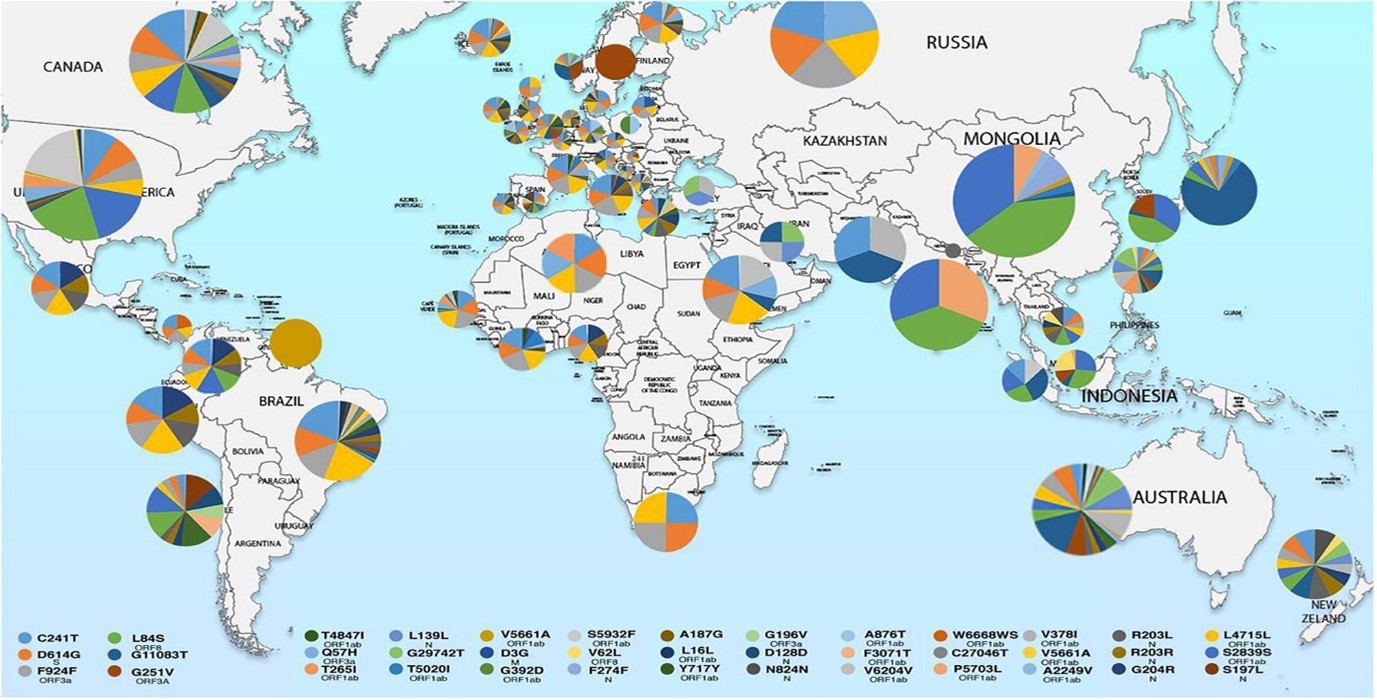It has been more than a year since we continue to face and fight this human catastrophe, a declared pandemic due to the spread of Corona Virus. It is a humanitarian, public health, and developmental emergency. The whole world is facing a common danger, regardless of race, gender or religion, for perhaps the first time since 1945. But though COVID-19 does not discriminate, our prevention and containment efforts do. The new SARS-CoV-2 coronavirus that continues to propagate across the globe may not be the same as the virus that originated in China’s Wuhan province at the end of 2019 and rapidly became the source of the worldwide COVID-19 outbreak in 2020. The reason behind the rapid spread is the process known as mutation that causes alterations in the genetic structure of any organism and like many other viruses, coronavirus is also prone to these changes.

Mutations in viruses are the modifications by where a virus replicates itself, even sometimes changing itself a little bit. A mutant virus is referred to as a “variant” of the original virus with one or several new mutations. The more viruses are circulating, the more they are prone to alter. Occasionally, these changes can lead to a virus variant that, compared to the original virus, is better adapted to its environment. This method of modifying and selecting successful variants is known as virus evolution.
Mutations can cause a change in the characteristics of the virus, thus altering the rate of its transmission and its severity. Some viruses are more prone to mutations than others. SARS-CoV-2, the virus which causes COVID-19, tends to change more slowly than others such as HIV or influenza viruses. This could, in part be explained by the virus’ internal “proofreading mechanism” which can correct “mistakes” when it makes copies of itself. There continue to be various studies conducted by scientists to better understand this mechanism and how it works. Four dominant variants of the virus have been discovered in different parts of the world since the outbreak began. In late January, the first variant was noticed, with D614G substitution in the virus gene, which was confirmed to be the Corona Virus variant a few months later, till June, as it started spreading with increased transmission and infectivity than the initial strain of the virus. Another dominant variation was spotted in August in Denmark, known as the ‘Cluster 5’, which was studied to potentially reduce virus neutralisation in human body thereby decreasing the immunity. Another variant was reported by the UK government in December which was named , ‘SARS-CoV-2 VOC 202012/01’ the origins of the strain remaining unknown. In December itself, yet another variant was reported by South Africa, which was rapidly spreading in three of its provinces. The variant is named ‘501Y.V2’

Genetic mutation happens with viruses and scientists typically tweak vaccine combinations from time to time to counter the mutated viruses. The tweaking of combinations is followed in the case of influenza vaccines. When a new virus strain arises, three main factors that need to be watched are transmissibility, pathogenicity (ability to cause the disease) and immunogenicity (to provoke the body immune response). The question therefore arises that whether these frequent virus mutations make the pandemic more dangerous than before? To answer this, it is imperative to note that Viruses live through its generations far faster than larger organisms like humans do. In the process, they replicate and evolve and need to maintain an optimal relationship with the surroundings and host to survive and propagate, thereby mutating according to the same. Lethal pathogens, like the initial spread of corona virus are likely to kill the host itself, thereby stunting the spread of virus. In simple terms, the virus does not evolve into more severe strains that causes itself to die out. Mutating viruses are more contagious, but with each mutation, the virulence of such viruses continues to decrease. And so, since it results in a milder strain, mutation is not something to stress or panic about. The mortality caused by this virus is weak, but in the younger generation, it spreads very rapidly.

Faster spread due to the frequently mutating virus might not create same percentage of morbidity in affected people but even small percentage of fatality in a large number of affected population can lead to huge number of deaths. Therefore, it becomes increasingly necessary to undertake the precautions and take preventive measures to avoid the rapid spread of the mutating virus that awaits us in future.
By Shivangi Goel
Sources :
- https://www.who.int/news-room/q-a-detail/sars-cov-2-evolution
- https://www.weforum.org/agenda/2020/12/coronavirus-mutation-science-explained/
- https://www.ncbi.nlm.nih.gov/pmc/articles/PMC7157960/
- https://www.un.org/en/coronavirus
- https://www.businesstoday.in/current/economy-politics/four-variants-of-coronavirus-found-since-beginning-of-pandemic-says-who/story/426803.html
Image references
- https://images.news18.com/ibnlive/uploads/2020/12/1608479964_coronavirus-london-1.jpg?impolicy=website&width=534&height=356
- https://globetechcdn.com/hospimedica/images/stories/articles/article_images/2020-06-26/SDD-1513.jpg
- https://www.frontiersin.org/files/Articles/567073/fgene-11-00854-HTML/image_m/fgene-11-00854-g001.jpg

Shivangi is a second year law student, pursuing BA LLB (Hons) from NMIMS Kirit P Mehta School of Law. She is deeply interested in the areas like psychology, politics, criminal law. She has volunteered and interned in NGOs , as well as law firms. She is currently working as a content writer for The Economic Transcript Blog and Magazine and she is HOD Design in a college committee.
